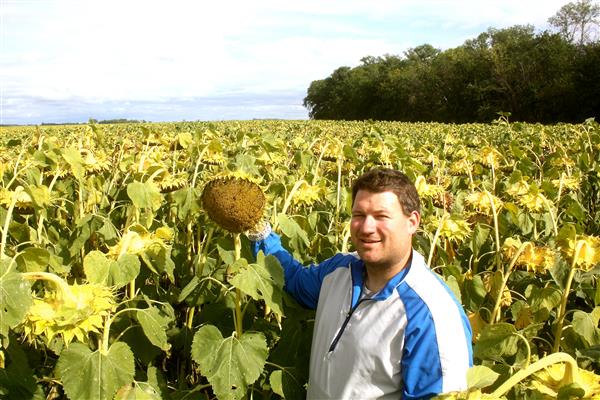Article Archives
Forward With ’Flowers in the Red River Valley
Wednesday, January 8, 2020
filed under: Rotation
 Taylor Glasow
Taylor Glasow
Taylor Glasow has no recollection of his father, Dallas, planting sunflower on the family farm near Davenport, N.D., in the late 1970s and/or early ’80s. That was a period during which Cass County, N.D., was the largest sunflower seed producing county in the nation.
Taylor’s lack of memory is understandable, given that he hadn’t even been born as of that era. His memory of sugarbeets, soybeans and corn is much more real, since those were the crops the Glasow family moved into after ceasing sunflower production. Many other Cass County producers moved away from ’flowers as well during the ’80s and ’90s, with corn and soybeans filling in much of the countryside. (Cass County has, in fact, had the highest number of soybean acres of any county in the nation in recent years.)
But things changed again in 2015 when Taylor, now farming in partnership with his dad, decided to give sunflower another shot. He grew confections that first year and then, in 2016, switched to oils when he was able to get an attractive contract from Cargill, which operates the multi-seed crushing plant in West Fargo, about a half hour from the Glasow farm. It was a good move. “The last two years, it’s been the best paying cash crop on our farm,” Taylor noted in late summer of 2019. He had 2,800 acres of oil sunflower in the ground this past season, up from 2,300 in 2018 and about 1,000 in prior seasons. The standard four-year rotation on the farm in recent years has been soybeans, then sunflower, followed by barley and corn.
Of course, as with many eastern North Dakota producers, Mother Nature threw some huge curveballs at the Glasows this past fall. Consistent, excessive rainfall, coupled with an October snowstorm, slowed crop maturity, delayed harvest, brought more disease (especially Sclerotinia) and eventually resulted in major harvest struggles and significantly lower yields. While in prior years the Glasows had been averaging around 3,000 lbs/ac on their sunflower with oil contents in the mid- to upper 40s, 2019’s final numbers came in at under 1,500 lbs/ac and oil content in the lower 40s, on average.
Discouraging? Of course. But Taylor lays it at Mother Nature’s feet and is looking ahead to 2020. Sunflower will again be a big part of his rotation. He expects to plant at least as many acres of ’flowers this upcoming season as in 2019 — “if not even a few more.” The negative 2019 experience simply evolved “from being way too wet,” he summarizes.
While obviously not as profitable in 2019 as in previous years, sunflower is “still sitting right in there” with his other rotational crops when it comes to the bottom line, Glasow affirms.
Taylor doesn’t plan any significant modifications to his sunflower production system, either. That’s part of the reason — along with the contract price — that he likes this crop: ease of production. “We plant, spray our pre-emergent, and that’s pretty much it until harvest,” he notes. The pre-emergent herbicide (Spartan®Charge) has been providing excellent weed control, he adds. Strong weed management in the other rotational crops likewise is a major benefit, as is the Glasow spring tillage regimen. “We field cultivate all our ground where we’ll have ’flowers,” he says. The Spartan goes on immediately after planting. “In fact, the sprayer ‘chases’ the planter, both usually in the same field at the same time.”
Fertility is based on a 3,000-lb yield goal, spring applied. “We own our own floater and spread it all ourselves,” Glasow says. “So we can cover a lot of ground in a day.”
While the Glasows no longer raise sugarbeets, their equipment is set up for 22” rows. Seed drop typically runs 24,000 per acre. That population, together with the narrower rows, provides a more-equidistant plant spacing pattern across the field, translating into a little quicker canopy cover — also aiding weed control.
Prior to this past fall’s difficult weather, about the only challenge Taylor recalls about producing sunflower in previous years came during harvest — i.e., the threat of combine fires. “We have a 185 cfm air compressor and a water truck in the field. We do not start a combine until they’re present,” he says. The Glasows employ a 40-foot Geringhoff SunLite header with 9” pans. “So we can combine in any direction. We always try to go where the engine compartment stays clean. So whatever the wind direction is, we change our angle accordingly and drive.”
Taylor’s combine fire concerns were essentially alleviated this past fall when he purchased two aftermarket fire prevention kits from DSH Engineering of Brookings, S.D. DSH is the company founded by now-retired South Dakota State University ag engineer Dan Humburg, who previously was instrumental in SDSU research into combine fire prevention.
Glasow was extremely impressed with the units’ performance on his Case IH 9120 combines and reports no fire problems during the 2019 harvest. “I would recommend them to anyone,” he says. “We went full days without blowing combines off, with no issues; sometimes even for [two or more] days. That was money well spent.” — Don Lilleboe